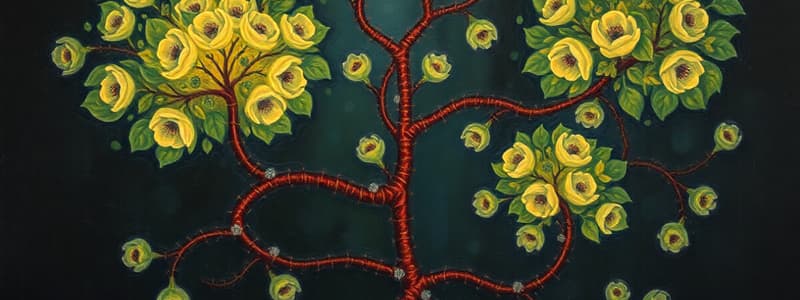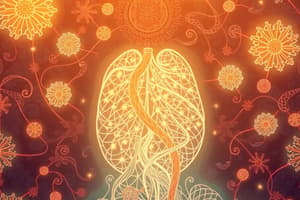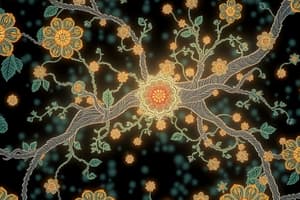Podcast
Questions and Answers
What is the total range of ATP produced from one glucose molecule during aerobic cellular respiration?
What is the total range of ATP produced from one glucose molecule during aerobic cellular respiration?
- 20-25
- 10-15
- 40-50
- 30-38 (correct)
How do the reactants of photosynthesis and cellular respiration compare?
How do the reactants of photosynthesis and cellular respiration compare?
- Both processes produce glucose from carbon dioxide.
- Photosynthesis produces glucose while cellular respiration consumes it. (correct)
- Cellular respiration generates carbon dioxide which is consumed by photosynthesis. (correct)
- They are entirely different and unrelated.
What is a key consequence of blocking the electron transport chain with cyanide?
What is a key consequence of blocking the electron transport chain with cyanide?
- Interrupted ATP production (correct)
- Increased production of ATP
- Immediate cellular repair
- Enhanced glucose metabolism
Which statement about fermentation is correct?
Which statement about fermentation is correct?
What can be a severe consequence of mitochondrial diseases?
What can be a severe consequence of mitochondrial diseases?
What is the primary purpose of aerobic cellular respiration?
What is the primary purpose of aerobic cellular respiration?
During glycolysis, where does the process take place?
During glycolysis, where does the process take place?
What is produced during the intermediate step of aerobic cellular respiration?
What is produced during the intermediate step of aerobic cellular respiration?
What role do NADH and FADH2 play in the electron transport chain?
What role do NADH and FADH2 play in the electron transport chain?
Which step of aerobic cellular respiration occurs in the mitochondrial matrix?
Which step of aerobic cellular respiration occurs in the mitochondrial matrix?
What is the final electron acceptor in the electron transport chain?
What is the final electron acceptor in the electron transport chain?
The majority of ATP produced during cellular respiration occurs at which stage?
The majority of ATP produced during cellular respiration occurs at which stage?
How many ATP molecules can be produced from one glucose molecule during the electron transport chain and chemiosmosis?
How many ATP molecules can be produced from one glucose molecule during the electron transport chain and chemiosmosis?
Flashcards
Cellular Respiration
Cellular Respiration
The process of breaking down glucose to produce ATP, carbon dioxide, and water.
Fermentation
Fermentation
An alternative way to produce ATP when oxygen is not available, less efficient than aerobic respiration.
ATP (Adenosine Triphosphate)
ATP (Adenosine Triphosphate)
The main energy currency used by cells to power their activities.
Cyanide
Cyanide
Signup and view all the flashcards
Mitochondrial Diseases
Mitochondrial Diseases
Signup and view all the flashcards
What is aerobic cellular respiration?
What is aerobic cellular respiration?
Signup and view all the flashcards
What is glycolysis?
What is glycolysis?
Signup and view all the flashcards
What is the intermediate step in aerobic respiration?
What is the intermediate step in aerobic respiration?
Signup and view all the flashcards
What is the Krebs cycle?
What is the Krebs cycle?
Signup and view all the flashcards
What is the electron transport chain and chemiosmosis?
What is the electron transport chain and chemiosmosis?
Signup and view all the flashcards
What is NADH?
What is NADH?
Signup and view all the flashcards
What is FADH2?
What is FADH2?
Signup and view all the flashcards
What is ATP?
What is ATP?
Signup and view all the flashcards
Study Notes
Aerobic Cellular Respiration
- Aerobic cellular respiration is the process cells use to break down glucose to make ATP, a crucial form of energy.
- It requires oxygen and occurs within the mitochondria of eukaryotic cells.
- All living organisms need ATP.
Steps of Aerobic Cellular Respiration
-
Step #1: Glycolysis
- Occurs in the cytoplasm.
- An anaerobic process that doesn't require oxygen.
- Breaks down glucose into pyruvate.
- Net yield:
- 2 pyruvate molecules
- 2 ATP molecules
- 2 NADH molecules. NADH carries electrons for later ATP production.
-
Step #2: Intermediate Step
- Pyruvate moves into the mitochondrial matrix.
- Pyruvate is oxidized.
- 2 pyruvate are converted to 2 acetyl CoA.
- Carbon dioxide (CO2) is released.
- 2 NADH molecules are produced.
-
Step #3: Krebs Cycle (Citric Acid Cycle)
- Takes place in the mitochondrial matrix.
- An aerobic process, requiring oxygen to continue.
- Acetyl CoA enters the cycle.
- CO2 is released.
- Produces:
- 2 ATP molecules
- 6 NADH molecules
- 2 FADH2 molecules. FADH2 assists electron transfer for ATP production.
-
Step #4: Electron Transport Chain and Chemiosmosis
- Happens in the inner mitochondrial membrane.
- An aerobic process.
- Electron Transport: Electrons from NADH and FADH2 are passed to protein complexes and electron carriers.
- Proton Gradient: Electron transfer pumps protons (H+) into the intermembrane space.
- Electrochemical Gradient: The accumulation of H+ creates an electrical and chemical gradient.
- ATP Synthase: H+ ions flow through ATP synthase, an enzyme.
- ATP Production: The flow of H+ through ATP synthase drives ATP production.
- Final Electron Acceptor: Oxygen acts as the final electron acceptor, forming water (H₂O).
ATP Production
- The majority of ATP comes from the electron transport chain and chemiosmosis.
- ATP yield varies based on conditions (e.g., efficiency of proton gradient).
- Estimated ATP produced from ETC and chemiosmosis range from 26 to 34 per glucose molecule.
- Overall estimations for total ATP per glucose molecule range from 30 to 38.
Comparisons to Photosynthesis
- The chemical equations for both processes are closely related.
- Photosynthesis uses CO2 and H2O to make glucose and O2.
- Cellular respiration uses glucose and O2 to produce CO2, H2O, and ATP.
Alternate ATP Production
- Fermentation: When oxygen is not available, cells use fermentation to create ATP. This process is less efficient.
- Importance of ATP Production: Cellular respiration is vital for all life.
- Cyanide blocks the electron transport chain, halting ATP production.
- Mitochondrial diseases disrupt mitochondrial function, leading to severe consequences.
Studying That Suits You
Use AI to generate personalized quizzes and flashcards to suit your learning preferences.



